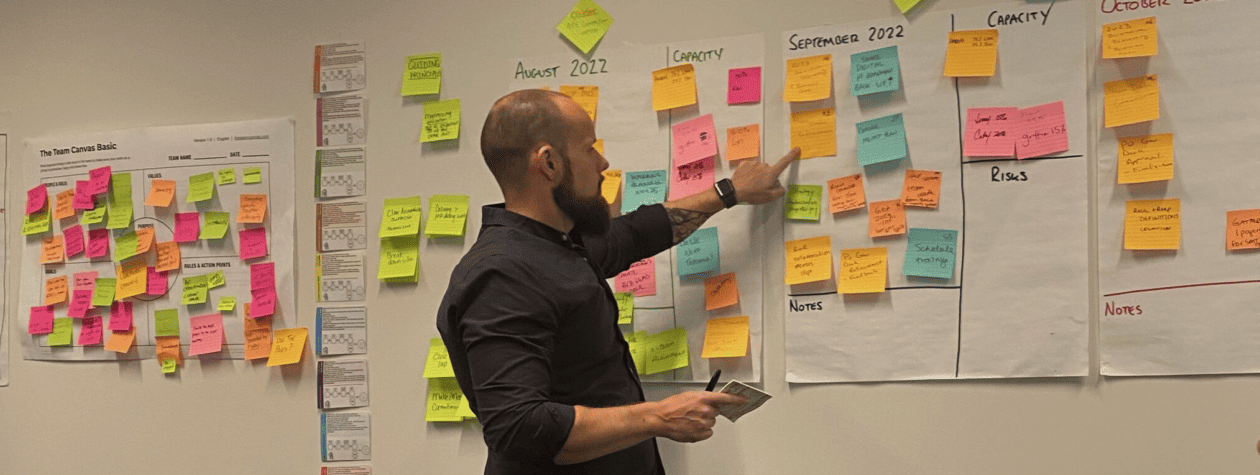We have recently been working with a set of diverse clients, from a cyber security company and logistic providers to manufacturers of a household British electronics brand. Despite their vast differences, they all have one thing in common – challenges with how they successfully execute against their strategy.
Our clients have asked questions like:
- “How can we do more with what we have?”
- “We need to get the departments speaking to each other!”
- “How do we know that we’ve delivered value?”
- “How do we ensure that we’re working together on the right stuff?”
These questions are all about strategic execution. Harvard Business School defines strategic execution as “the implementation of a strategic plan to reach business goals and objectives. It comprises the daily structures, systems, and operational goals that set your team up for success.”
Failure to Translate Strategic Visions Into Tangible Results
Strategic execution is the heartbeat that propels organisations forward. Yet, it’s no secret that many leaders face hurdles in effectively translating their strategic visions into tangible results. According to studies, 60-90% of all strategic plans fail to launch and 48% of all organisations fail to meet at least half of their strategic targets.
At McKenna Agile Consultants, we understand these challenges firsthand, having worked closely with clients navigating the intricate path of strategic execution. In this post, we shed light on some common stumbling blocks and unveil the power of embracing agility to surmount them.
How to Overcome Strategic Execution Hurdles in Your Organisation?

Rigid Plans in a Dynamic World
Traditional strategic plans often resemble concrete fortresses in a world where change is the only constant. Last year we wrote about ways to increase your strategic agility, through embracing an incremental approach to strategy development, using the concept of thinking about it as a series of two-way doors, enabling you to experiment continuously as the strategy evolves.
Ask yourself:
- How well are we communicating our strategy?
- Are our people, teams, projects working towards that strategy?
- Are we validating/measuring/governing that our people, teams, projects are progressing towards the goals of the strategy?
- How agile/flexible to change/adaptive is our strategy?
Silos Stifling Collaboration
Siloed departments can hinder the seamless flow of information and collaboration essential for effective execution. Our clients lament the disconnect between strategy formulation and execution, resulting in disjointed efforts and missed opportunities. Agile approaches emphasize cross-functional teams working collaboratively towards common goals, breaking down silos and fostering a culture of shared accountability.
Our work implementing OKRs has enabled clients to address this challenge head on. We’re helping a client to implement the concept of “Squad Based” OKRs to quickly spin up cross functional teams spanning multiple functions to rally around achieving a specific key result.
Lack of Alignment and Transparency
Misaligned priorities and obscured objectives plague many organisations, leading to confusion and inefficiency. Too much work in process (WIP) is the number one bottleneck that we are helping our clients to overcome.
We’re noticing misalignment where leaders are trying to support their people to avoid stress, burnout and fatigue, but subconsciously contradicting this by continuing to overload the teams and confusing the act of prioritsation with the act of saying no to things.
Prioritisation is not about solely disregarding ideas or initiatives; it’s about being clear on where you should focus your attention next.
Sound familiar? Start by visualising your current initiatives that you’re working on. We facilitated a series of strategy days for a client to help them visualise their WIP and plan their roadmap for the coming months. We tend to spend a lot of time being busy and talking about work, but it’s not until you visualise it that you can appreciate the true volume.
If you want to bring objectivity to prioritisation, build alignment between stakeholders and implement consistency in the process, check out our post on Weighted Shortest Job First.

Embrace Agile to Conquer Strategic Execution
We are seeing our clients come to us from areas outside of IT and software, within the wider business context asking us to help them solve the same problems. It’s no longer about just “doing Agile”, rather using tried and tested agile approaches to help solve real business problems.
Objectives and Key Results (OKRs) are beginning to come to the forefront as a tool to improve strategic execution. They help to bring a laser focus to priorities, bring alignment across multiple departments, invite commitment by empowering teams to set their own OKRs, foster a culture of maximum transparency and encourage teams to stretch beyond what they thought was possible.
At McKenna Agile Consultants, we are ready to guide you on your journey towards agile transformation, equipping you with the tools, knowledge, and support needed to overcome strategic execution hurdles and achieve your boldest ambitions.
Let’s embark on this transformative journey together.
Try our free AI-powered strategy and OKR assessment tool and get in touch to discuss your results.


